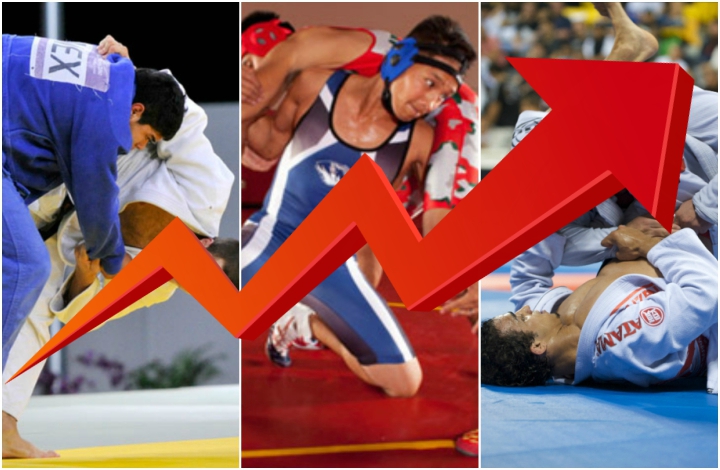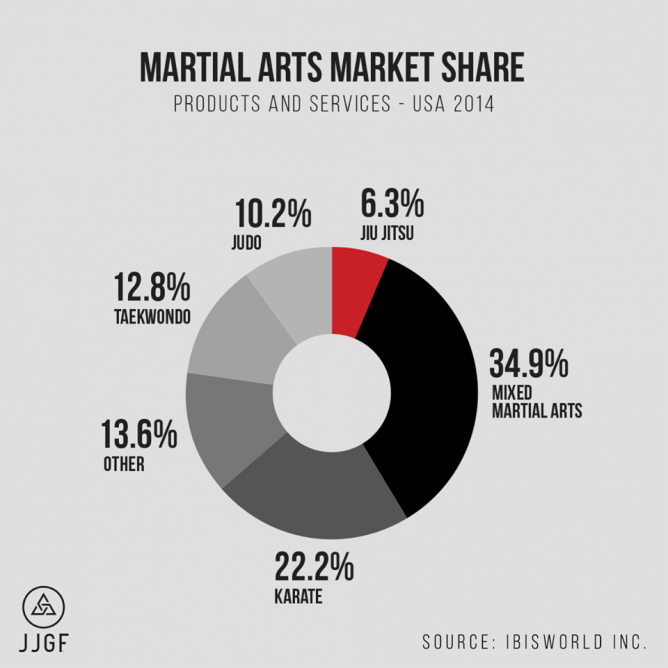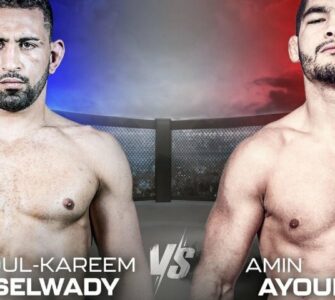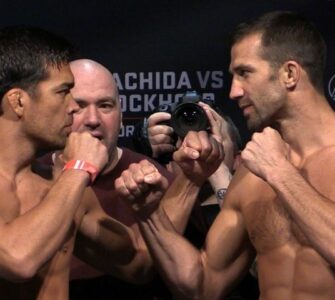According to the ibisworld inc. bjj has only a 6% market share among martial arts in America. Pedro Sauer commented that the friendly introduction with katas makes karate, taekwondo and judo more approachable plus, he mentioned there was the added effect of long history and exposure through movies and the Olympics. While his comments are colored with his new affiliation I couldn’t help but wonder to which degree this is true.
The international Judo federation claims Judo is the 2nd most popular sport in the world (a somewhat disputed claim), it certainly has a much longer tradition and even some representatives yet it’s not all that profitable in the biggest market of the world. Why is this happening and could there be a common thread with Brazilian Jiu-jitsu?
In spite of Master Pedro Sauer’s words I would argue that judo is not very user friendly. In fact I’m frequently much more intimidated by the judo throws I encounter than by wrestling or bjj for example.
So why is Judo deserving of such a small market share?
The story goes back to the end of the Cold War. In 1992, Olympic sponsorship changed from governmental to commercial and the IJF subsequently started financing its budget directly from television rights, advertising rights and marketing rights to IJF events. While there were substantial markets in Europe as well as Japan, there was no breakthrough in the North American Market.
As it turns out, American and Canadian television networks weren’t all that eager to show their nationals routinely losing to the Japanese, Cubans, Russians and Koreans. This is something Judo and BJJ have in common. When you look at the round-up of winners of any BJJ competition through the history it’s clear that the USA isn’t really dominating. For example here’s the ADCC list of Champions:
So why is Judo still doing better than BJJ?
Arguably, judo is still riding the coat tails of Ronda Rousey’s fame. She’s become a household name through the temporary domination she asserted in the women’s bantamweight category in the UFC. And further USA just recently managed to snag their first golden Olympic medal in Judo via Kayla Harrison in 2012.
One entry in the journal of martial arts and sciences from 2001 even compared the funding American judo receives with archery and small-bore riflery?! All of this validates the stories of struggle told by Ronda’s mom – judo Olympian (and an impressive scholar to boot) AnnMarie Demars. Back in 2015 she talked about Judo’s worldwide decline.
http://theselfdefenceexpert.com/wp-content/uploads/2014/02/usa-bjj-data.png
The things in IJF aren’t really all that tragic as they’ve made them out to be. Over the years they’ve made several very lucrative deals notably with Coca Cola and Hyundai and yet the IJF’s official auditing report for 2014 details total income of 17 million of Swiss Francs but it also shows their expenses are 16.8 million. The majority of money (7 million CHF) was made came from licensing fees but about the same amount was then spent on travelling expenses.
Another Olympic sport had its share of rough tumbles due to mistakes made by the governing body – Wrestling. Back in 2013 wrestling was faced with a serious conundrum: the international Olympic committee decided to drop wrestling from the summer Olympics from 2020 onwards because they decided they no longer had time for all 26 core sports. Long history didn’t really factor into the decision as much as poor viewership numbers. Luckily, FILA later renamed itself to United World Wrestling managed to edge out other sports and secure a non-core sport spot.
A recent Pedro Sauer bjj black belt, Mark Schultz can attest to the harsh living in wrestling during the 80s. In fact, hard life conditions forced Olympic winner Mark Schultz to resort to living at the Foxcatcher farms with the eccentric millionaire John Du Pont who would ultimately end up murdering his brother David (also an estimeed wrestler).
Wrestling is ancient compared to NFL, NBA and MLB and is the only sport to be mentioned in the bible yet wrestling is often done for pure pride and very little money. NBA is watched by 20000 fans and NCAA wrestling numbers are somewhere between 20000 and 40000 spectators depending on the venue. But there’s still not much money in it for the players. Wrestlers typically enjoy some type of a college scholarship but with little promise of a profitable career afterwards unlike the mainsteam American sports like basketball, baseball or American football.
There’s also an issue of how MMA is impacting amateur wrestling and judo. Many promising wrestlers are in fact turning to MMA as that’s where the money is. But some point out how wrestling is the only sport in high school or college that prepares for MMA and as such should in fact be rising in popularity. The viewership and the attention wrestling receives during this year’s Olympic games will surely help decide the future of both judo and wrestling.
UFC is playing up the conflict between combatants more and more with every passing event but the when it comes to the actual fight we see a lot of Brazilian jiu-jitsu. When we talk about wrestling in the martial arts community we often frown about the WWE type events but truth be told there are records as old as 160 years before Christ that document roman boxing and wrestling were as much theatrical acts as combative sports. This is interesting especially contrasted with judo. Judo has never had such dramatic portrayals but then again – also never enjoyed nowhere near the popularity wrestling has in the American culture.
While a decline is in the cards for both wrestling and judo, in judo’s case the governing body shoulders some of the blame. They frequently tried to break out into the American market but with every step they made forward, they also stepped a bit back. A clear example for this was introducing the blue uniform way back only to follow that welcome change with additional rules that significantly complicated the refereeing.
On the other hand, BJJ is young and ever-expanding. The growth of MMA has shined a light on bjj for the average American male who can’t wait to learn and then tell all his friends about it. And of course with the 18-45 demo you typically have a crowd whose habits are just forming and who aren’t afraid to invest their own money into it. Dropping the Brazilian from bjj probably seems like the best next move, especially considering the importance of the American market.
You can also read here on how the growth of MMA and BJJ caused the downturn in popularity of Aikido.
“Judo, the Olympics, and Television” By Joseph R. Svinth, Electronic Journals of Martial Arts and Sciences, Feb 2001
http://web.archive.org/web/20080723184745/http://www.ijf.org/congress/cg97-25.html
https://unitedworldwrestling.org/organization/history
http://www.bbc.com/sport/olympics/21427455
http://bleacherreport.com/articles/52813-wrestling-mans-toughest-and-oldest-sport
http://ejmas.com/kronos/



















